In this post, I review ACE Academy, an English-language commercial visual novel that was developed by PixelFade Studio, a Canadian development studio. ACE Academy was first released for Windows, Linux, and MacOS on August 22, 2016. The player takes the role of a nameable protagonist who is half-American and half-Japanese. The protagonist is a college student training to be a GEAR pilot (GEARs are large, humanoid robots). The game picks up with the protagonist and his younger sister, Nikki, moving to Japan from the United States to live with their Uncle after the deaths of their parents. The protagonist transfers into the piloting program at ACE Academy and thereafter is presented with a large number of choices and decisions as he works with his team to win scholastic GEAR fights. Along the way, gets to know his classmates and enjoy life in Japan.
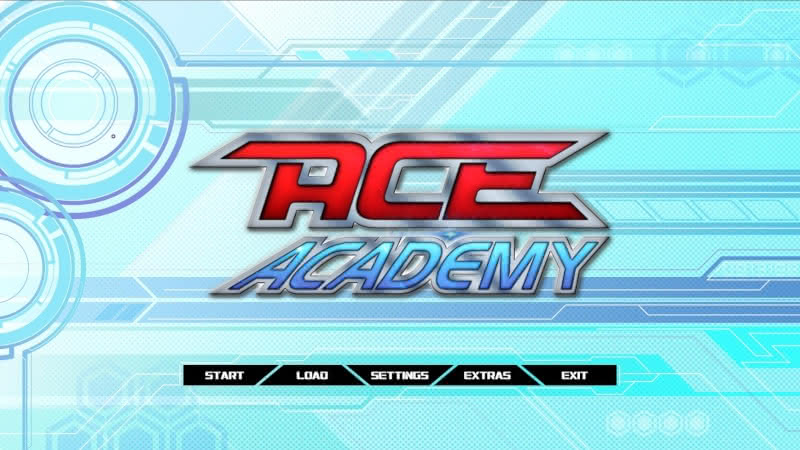
I post two notes before beginning my review. Firstly, I played the Linux version of ACE Academy on my computer. The visual novel was subsequently released for Android and iOS devices, but I have not played the mobile ports of ACE Academy. Thus, while my impression is that the mobile ports feature the same content, I am only reviewing the computer version of the game.
Before I start the instant article, I will direct you to a separate Leaflet about my history with ACE Academy. While I did not get around to playing ACE Academy until spring 2022, my first encounter with the project was a 2014 demo by PixelFade Studios called Kendo Crush! The team abandoned Kendo Crush and reworked the game into ACE Academy. I describe my memories of Kendo Crush! and evolving impressions of the project here.
December 31, 2022 update: I published my review of Kaori After Story, a side-story sequel to ACE Academy. As its name suggests, Kaori After Story follows from the Kaori Itami route of ACE Academy.
Non-Spoiler Notice
While I will discuss the plot, characters, and mechanics of ACE Academy in broad terms, the instant review will not spoil major plot events and resolutions in a way that would ruin the experience of playing and reading ACE Academy for those of you who may be interested in the game, but have not yet played it. I am writing the review because I think that ACE Academy is an interesting project, but the review may also serve an additional purpose of helping readers decide whether the game may be something worth purchasing. However, if you already have ACE Academy in your library and on your to-do list, you may prefer to go into the game entirely blind before consulting my review, notwithstanding the fact that my review is free of major spoilers.
While I do not discuss specific plot points and developments with specificity, I allude to them in ways such that readers who are already familiar with ACE Academy should understand what I am referencing and discussing. Thus, the instant review may serve as a comprehensive assessment of ACE Academy for those of you who have already played it in full or in part.
ACE Academy Details
I present the details for the computer version of ACE Academy:
| Title: | ACE Academy |
| Dev/Publisher | PixelFade Studio |
| Release | August 22, 2016 |
| Platform | Windows, Linux, MacOS |
| Engine | Ren’Py |
| Store | Steam |
| Official Website | PixelFade Studios |
| Visual Novel Database | Page |
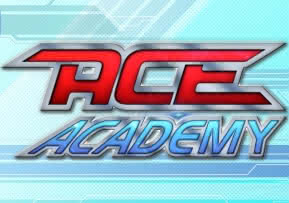
If you are interested, I strongly recommend waiting for a sale to buy ACE Academy on Steam – at which time it is often available for as low as $4.99. As I noted in the introduction, PixelFade Studio released a small sequel game titled Kaori After Story.
(Note: Many of the images in the Visual Novel Database link are for the 2014 Kendo Crush! demo instead of ACE Academy.)
Steam Version of ACE Academy is DRM-Free
Although ACE Academy is only available for purchase on Steam, the game itself is DRM-free. This means that the ACE Academy executable can be launched from outside of Steam and without the user being logged into Steam. For whatever it is worth, I purchased ACE Academy on Steam but ran the game fully locally and outside of Steam for purpose of my play-through and review. The sequel game, Kaori After Story, is also DRM-free (see review).
I explained the relevant concepts surrounding Steam’s DRM-protection and the surprising number of DRM-free games on Steam in a separate article.
Mobile Versions
ACE Academy was released for Android on September 17, 2016, and for iOS on May 19, 2020. As I noted in my introduction, I do not own, and have not played, the mobile versions of ACE Academy. While they appear to be identical to the computer version, and I could see some benefit to being able to make certain choices using a touchscreen instead of a keyboard and mouse, my review is strictly of the computer version of ACE Academy. For those of you who are interested, you will find links to the Google Play and App Store pages.
Broad Overview of What ACE Academy Is About
ACE Academy takes place in Japan in 2049. While the game is clearly set in the future, the world presented is much like our own. Characters order food, go to restaurants, watch movies, take trains, and ride motorcycles. The main futuristic element presented in ACE Academy are GEARs. What is a GEAR? I turn to the official description of ACE Academy on its Steam store page:
In the year 2049, mechanized robots commonly called GEAR were developed for military application. Since then, their versatile functionality has led them to not only become commonplace in commercial use, but also spawned an entire sports entertainment industry. The prevalent use and popularity of GEARs has created a new academic field known as “Cenorobotics”.
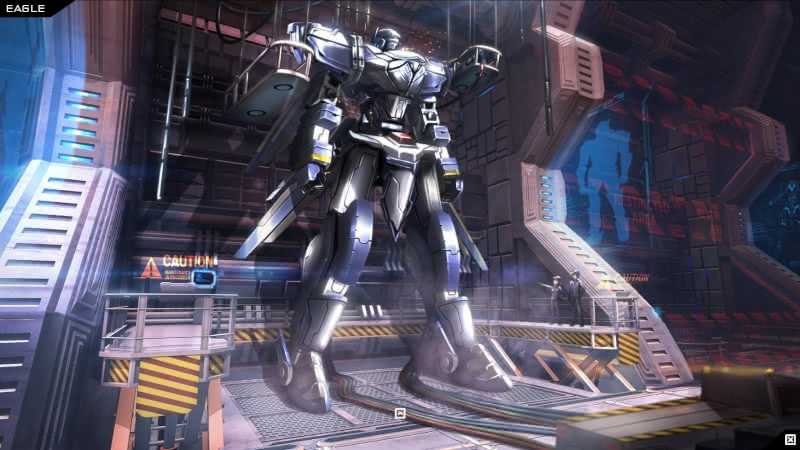
The protagonist and view-point character of ACE Academy is a half-American, half-Japanese college student who attending a college GEAR piloting program. He grew up in the United States but moved along with his high school-aged sister, Nikki, to Japan to live with their Uncle after the death of their parents.
(NOTE: ACE Academy allows the player to choose a first and last name for the protagonist. For example, my distinguished New Leaf Journal colleague, Victor V. Gurbo, unsurprisingly named the protagonist RICHARD NIXON for his play-through. The protagonist’s little sister, Nikki, will always have the last name that the player chooses for the protagonist. The default name is Tristan Spade, but for purpose of the instant review, I will refer to the protagonist as “protagonist.” When I refer to the “player,” I mean the person who is actually playing the game and making choices for the protagonist.)
In Japan, the protagonist transfers into the elite piloting program at ACE Academy. The school holds intramural GEAR battles wherein teams of four students compete against each other. The protagonist joins a team consisting of fellow piloting students Shou Shinjirou, Mayu Akemi, and Kaori Itami very shortly after beginning his new school life. He also befriends, and is helped by, a psychology student named Yuuna Misaki and an engineering student who is also a foreign transfer student, Valerie Belle.
Notwithstanding the presence of robot fights, ACE Academy is a relatively laid back affair. It is a visual novel with two faces. Firstly, there is an overarching plot revolving around the mysterious and powerful “core” of the protagonist’s gear and its connection to the research and development work of the protagonist’s late father. The overarching plot runs its course regardless of how the player chooses to have the protagonist spend his time. However, ACE Academy is a highly interactive visual novel that offers the player a large number of choices relating to how the protagonist spends his time and how the protagonist responds to various situations. Most (but not all) of these choices concern the protagonist’s school and social lives. Through these choices, the protagonist can grow closer to the five main characters that he attends ACE Academy with. Eventually, the protagonist can lock in a romantic relationship with Mayu, Kaori, Yuuna, or Valerie, or follow the story arc of the designated “bro” character, Shou.
Having now completed a broad introduction to ACE Academy, I move on to review different parts of the game in more detail.
Length
Visual Novel Database indicates that ACE Academy takes about 20 hours to fully complete. I think that is longer than it will take most readers, but I have been told that I am a fast visual novel reader.
I took somewhere in the range of three-and-one-half hours to complete my first full play-through (Yuuna’s route). While completing the other routes, I took time to restore from a number of save points to try different choices and test what would happen and what effect they would have. By the time I completed the last of the routes (Kaori’s), I had clocked in somewhere between 16 and 17 hours. However, as I will explain before, ACE Academy includes a number of useful features that make it quick to skip through read dialogue and restore save points en route to trying different choices and completing different character arcs.
Content Notes and (Un)Warnings
Many visual novels that have dating elements include sexual content. To be sure, this is far from a rule – and I have already reviewed many visual novels here at The New Leaf Journal with no graphic content (we are, of course, a family website). But a cursory look through the visual novels available on Steam, GOG, or Itch, much less on sites specifically geared (ACE Academy pun intended) to selling Japanese visual novels, will find that the genre is no stranger to sexual content. One may fear (or hope, I do not know) that ACE Academy, featuring some “dating sim” elements and a college-aged protagonist and heroines, may have sexual content.

ACE Academy itself does not include any graphic sexual content, lest one believes that a handful of cuddling or kissing CGIs should trigger an Adults Only rating. Moreover, there is no “adult” or “uncensored” version of ACE Academy – there is only the versions available on Steam, Google’s Play Store, and Apple’s App Store.
Although the protagonist and all of his potential love interests are in college, and three of the four (Valerie being the exception) are old enough to drink, the level of intimacy in their relationships far more closely resembles awkward anime high school students than it does the relationships found in less wholesome visual novel and television affairs. This is especially true in the cases of Mayu and Kaori.
While ACE Academy is far from an adult game, there are some ordinary content warnings that should apply and render it unsuitable to younger audiences (however, the game is probably too text-heavy for said younger audiences in any event). While romances in ACE Academy are relatively chaste, many potential dialogue choices include sexual innuendo, and Valerie’s dialogue is often innuendo-laden regardless of how the player decides to interact with her. There are a few scenes that involve drinking and at least one character who does not handle alcohol entirely swimmingly. In terms of appropriateness, I would consider the last two Persona games, Persona 4 and Persona 5, both of which received M for Mature (17+) ratings, and the former of which had a heavy and in-game-noted influence on a number of ACE Academy scenes and characters, to be decent analogues – although ACE Academy lacks the modest violence and darker themes of the Persona entries as well as some of the interesting (operative word) Persona designs.
Comprehensive Review
Below, I will review the different components of Ace Academy in individual sub-sections.
Structure and Mechanics
Visual novels come in two varieties: Interactive and kinetic. Interactive visual novels invite player input through making choices and, in some cases, minigames or quick-time events. Kinetic visual novels are purely text-based with no player interaction.
ACE Academy is a highly interactive visual novel. The player will never go more than a couple of minutes without being presented with a dialogue choice. However, there are different species of interactive visual novels. Some interactive visual novels present the player with choices that meaningfully affect the story – see my reviews of Save the Date and Night of the Forget-Me-Nots for examples. Other visual novels present the player with meaningless choices. That is, the choice may affect the course of dialogue in a particular scene or conversation, but it ultimately has absolutely no effect on the story. See my review of May Sky for an example.
ACE Academy contains a mix of meaningful choices and choices that exist more for fun and to add variety to the play-through. A minority of the choices are timed, meaning that the player has a limited time (usually five seconds) to choose from several options. It is not immediately obvious in the first instance which choices alter the course of the story and which choices exist to add character to a play-through. I will explain how choices in ACE Academy work from a technical perspective while also not being so specific as to over-explain the mechanics for those who may be interested in reading the story for themselves.
To begin, ACE Academy is roughly broken into three sections. The first and second sections and the second and third sections are each separated by a small scene wherein the protagonist narrates a time skip. The protagonist’s narration changes a bit based on the player’s choices in the previous period (especially between acts two and three). The protagonist can “lock-in” a character route in the second act. The character route then plays out mostly in the third act. Unsurprisingly, the protagonist can pursue the character routes of his four female friends: Mayu, Kaori, Yuuna, and Valerie. Some players may miss that the bro-character, Shou, also has a character route, albeit it differs from the girls in that it is not romantic. There is also a path that occurs when the protagonist fails to lock in any character route in act two, but its unique scene exists primarily for comedic purposes and thus will not be a focus in this review.
I classify the types of choices that the player encounters in his day-to-day life in two ways.
The first type of choice that the player encounters are in-scene choices.
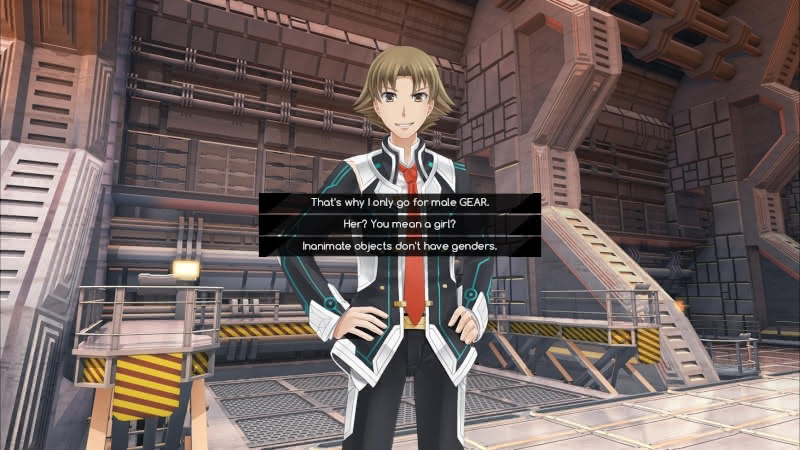
The very first choice in ACE Academy is an in-scene choice wherein the protagonist must decide how to respond to his sister’s trying to wake him up on the train.
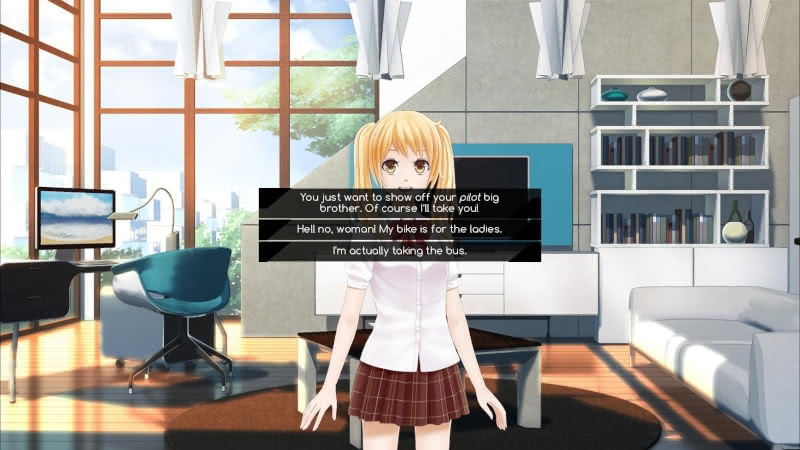
Most, but not all, of the in-scene choices have localized effects, meaning that they affect the course of a particular scene but not the overall story.
The second type of choice that the player encounters are scene-selection choices. To use an example, the protagonist may have just finished a class scene and be presented with a choice of how to spend his time. Instead of being presented with a dialogue option, the player may be presented with a list of available characters, almost always being some combination of Shou, Mayu, Kaori, Yuuna, and Valerie (Nikki shows up as an option occasionally).
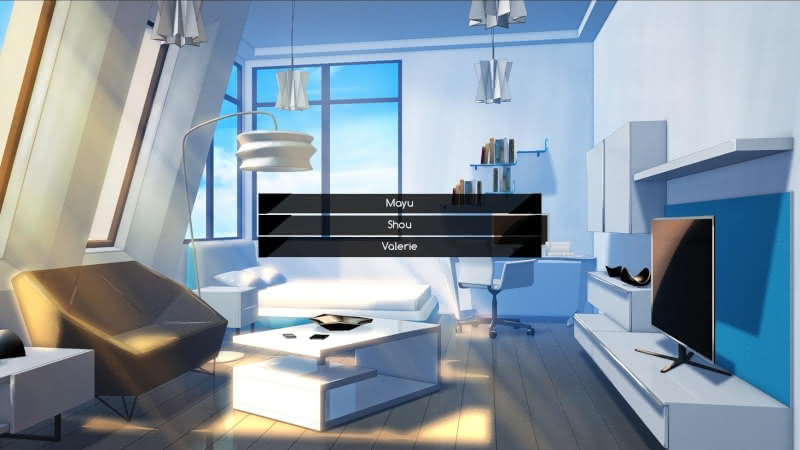
As the game progresses into its later stages, the options for who the protagonist has to hang out with will sometimes be influenced by how he had been spending his time in earlier scenes.
As a general rule, ACE Academy turns more on how the protagonist spends his time than what the protagonist does in that time. This rule is not absolute. For example, locking in the route of any of the girls does require some in-scene choices, and I will note that while none of the routes are difficult to find, Kaori’s is a bit finicky compared to those of Mayu, Yuuna, and Valerie.
Finally, I address the timed choices in ACE Academy. A non-significant number of choices come with a five second time-limit. In almost all of the timed-choices, the majority of options are clumsy or sub-optimal. I will use one meaningless timed choice as an example. There is a scene in which the protagonist is on his campus quad and the game’s text informs the player that a Frisbee is flying at the protagonist. The protagonist is given five choices, with two being to catch the Frisbee or dodge it, and the other three being less-than-graceful.
While a few timed choices exist in daily life scenes, ACE Academy makes the most creative use of them in the in-game intramural robot fights.

The protagonist is tasked with a series of decisions regarding attack and defense. In most cases, the protagonist’s choices do have a meaningful effect on the course of the battle.
Character Attributes
Before I conclude the mechanics section, I will make a brief note of the first choice of sorts that the player is offered after naming the protagonist. Before the game begins, the player is asked to choose a strong attribute for the protagonist. The player can make the protagonist athletic, intelligent, or intuitive.
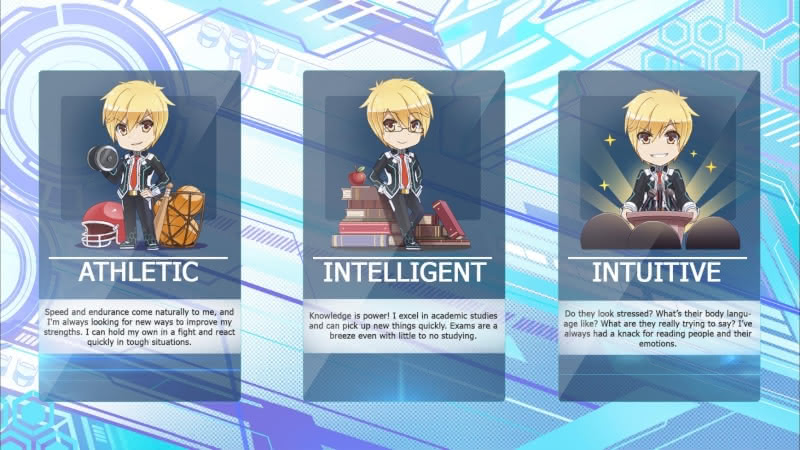
None of the three choices ultimately determines opens or forecloses any routes, and I do not think that the promise of the attribute choice is fully realized. However, each attribute does have minor effects on the game-play and, at several points for very intuitive (pun intended) readers, on the dialogue. I will leave it to ACE Academy players to try the attributes and see how they affect game-play in subtle ways.
Plot, Story, and Characters
Having established the necessary background of what ACE Academy is and how it is structured, I move to assess its plot, story, and characters, as best as I can without spoiling the major points for potential readers. Because the overarching plot progresses regardless of what the protagonist does whereas the character arcs are clearly influenced by the protagonist’s choices, I will cover each proverbial half of ACE Academy’s story in turn.
Overarching Plot
The overarching plot of ACE Academy surrounds Eagle, which is the mysterious “core” at the root of the protagonist’s GEAR. Early in the story, the Eagle proves to have some special properties that benefit the protagonist’s GEAR-combat team and capture the attention of those around him. Although the protagonist had built Eagle with his late father, he was as unaware of the special properties of Eagle’s core as everyone around him.
Eagle’s core plays an out-sized role early in ACE Academy, and it lurks throughout the story, sometimes returning to the forefront of affairs. The situation involving the protagonist’s core is not entirely isolated to segments involving the protagonist’s scholastic gear fighting team or those focused on his family. The core plays a central role in bringing Valerie, one of the main characters and potential heroines, into the story.
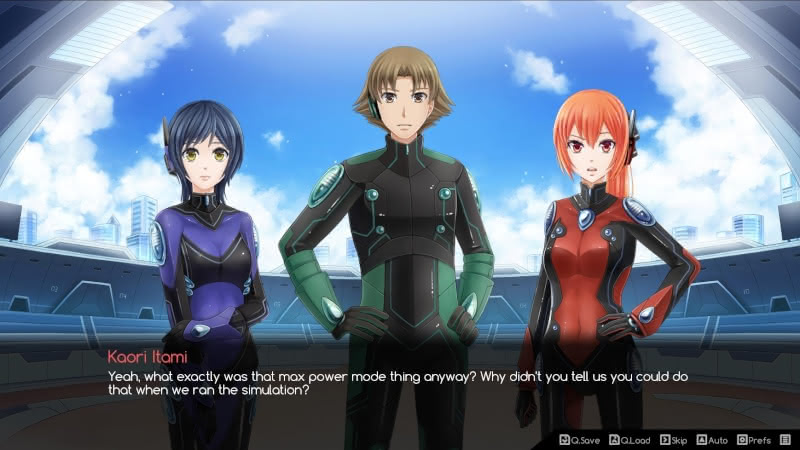
With the general overview aside, the overarching plot of ACE Academy comes off as half-baked and unfinished. Throughout the course of the story, ACE Academy slowly adds intrigue to the core plot, which does ultimately culminate in a resolution of sorts. However, much is left unexplained. The game finds a stopping-off point with respect to the overarching plot, but the stopping-off point feels more like it should be the beginning of something new than the end of things.
While I do not know the full development arc of ACE Academy, I came away with the impression after reading that some ideas for the core plot and the science-fiction mystery that the novel works to set up were left on the cutting room floor. What is left is a plot that is not out-of-place in the context of ACE Academy, but it never lives up to the promise of its slow dramatic build-up. Those expecting a game that is primarily about robots and science fiction will be left wanting by ACE Academy, which is, in the main, a slice of life comedy and character drama with robots and an unfinished mystery plot on the side.
In a final note, I will address briefly ACE Academy’s short successor game, Kaori After Story (see full review). As the name of Kaori After Story suggests, the sequel picks up with events that occur after ACE Academy when the player pursues the character route of Kaori Itami. While Kaori After Story has a different feel than ACE Academy, I did note that no reference was made to the dramatic events at the end of the first game – which ultimately involve Kaori on her route. It seems that whatever plans PixelFade Studios had for the sci-fi mystery involving the core, it had mostly lost interest when it came time to produce a sequel featuring the team’s most appealing character.
Characters and Their Arcs
Having noted that ACE Academy is not, first and foremost, a game about robots, science fiction, and intrigue, I turn to what it is primarily about, the day-to-day life of a college student in 2049 and his friendships and relationships.
Throughout the story, and especially in the first two-thirds of the story, the protagonist has the opportunity to get to better know his GEAR teammates (Mayu, Kaori, and Shou) and two additional classmates (Yuuna and Valerie). All five of these characters have a route that can be locked in during the second part of ACE Academy and viewed in full during the third. The routes of the four girls have romantic elements.
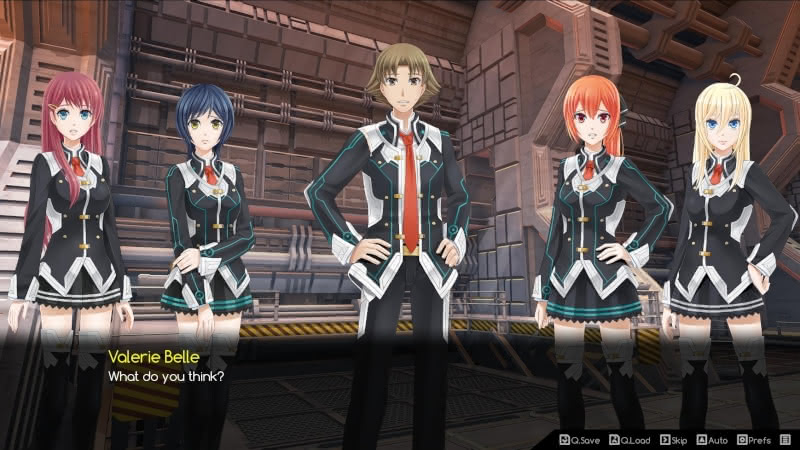
The character arcs mostly avoid the kind of melodrama that is common in many visual novels. All of the characters have certain problems and challenges, but with the debatable exception of Shou and the protagonist himself, those challenges are down-to-Earth and relatable.
Prior to locking in one of the character routes in the second of three parts of ACE Academy, we have what qualifies as a sort of common route wherein the player, making decisions for the protagonist, can get to know his classmates and ultimately (especially in the second part) decide which classmate(s) to prioritize. Once the player locks in a specific route, he or she gets to know the protagonist’s character in question better.
Below, I will provide a brief introduction to the characters and, insofar as possible, a spoiler-free assessment of the quality of their story arcs.
Shou Shinjirou is the only male character in ACE Academy who has a route. He is the quintessential “bro” and “best friend” character, and Persona 4 fans should have little difficulty gleaning the inspiration for his character design. Shou has a tendency to make a fool of himself and irritate Kaori, but he is also portrayed as a competent GEAR pilot who is capable of being serious when circumstances demand it.
While Shou’s character does not break new ground, I found that he serves his role well in the early part of the game, and he provides some good comedy and scenes when the player focuses on one of the routes of the four girls. Moreover, unlike many characters of Shou’s archetype, he has his own romantic circumstances that may, in some cases, be affected by choices that the player makes.
In one sense, I appreciated the fact that PixelFade Studios saw fit to give Shou a route – far from a given in a game wherein the player can date one of several attractive young 2D women. However, after completing Shou’s route second-to-last, I came away with the distinct impression that Shou is best left to play an important, but supporting role. The drama in his route erred too much on the melodramatic side, and the delivery did not feel credible. While Shou is arguably a stronger character than two of the girls, he has the weakest character route of the five possibilities.
Mayu Akemi is a kind but reserved girl who fits into a general shy-girl archetype. While she is perhaps not the sort of character that one would imagine being an elite piloting student, she comes from a family of famous GEAR pilots.
Mayu’s character suffers a bit in the early stages of ACE Academy from the fact that she has a weaker personality than Shou and Kaori, the two characters she most often shares the screen with early in the game. Mayu does play a key role in story-lines involving the GEAR-fighting team, especially in scenes where she asserts herself, but she has the tendency to fade into the background in play-throughs in which the player does not make an effort to spend free-time periods with her.
Mayu, like Shou, is better-suited to be a supporting character than a main character. Her character route with the protagonist feels a bit off at every level. Her early scenes lack the wit and sentimentality of the best character scenes, and the beginning of her character arc with the protagonist feels forced and lacks credibility. To the extent Mayu is the main character of her own route, I came away with the impression that the writing team did not have as distinct of a feel for writing her as it did the other main characters. She experiences her best development in the end when the player opts to pursue other routes.
Kaori Itami is – not even subtly – the favorite character of the PixelFade Studios team, and one would have that impression without knowing that there is an entire sequel game that picks up where here character route ends. The sequel features only a single (telephonic) cameo by one of the five other main characters from ACE Academy proper.
Kaori, a pilot on the protagonist’s team, is the designated tsundere character, which roughly means she comes off as harsh on the outside (strong tendency to violence and calling people, often Shou, idiots) but she has a softer side when one gets to know her.
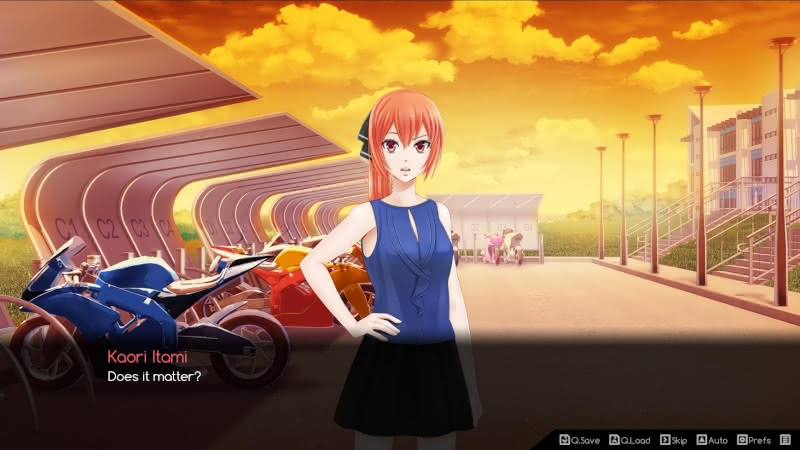
Kaori is ultimately the strongest character in ACE Academy with the best character arc, and her only credible rival in these regards – in my modest opinion – is Valerie. However, I note that PixelFade Studios leaned hard into the tsun half of tsundere with Kaori in the early going. She is let down by yelling too much in the early game (accentuated by voice acting, which I will discuss further down in the review), and she generally leaves a poor impression in early common route scenes. This impression, I fear, will lead many players, including yours truly (granted, I planned to leave Kaori for last since I had Kaori After Story in my library), to avoid spending time with her in the early going. Ultimately, she is allowed to show some depth to her character and smooth out the rough edges.
Kaori’s own scenes are consistently solid, and her character arc, wherein she proves to be a strong character beyond being a tsundere, features some of the best scenes and writing in ACE Academy. Being a tsundere, Kaori does not come off well if the player never invests time into her character, but she never fails to leave an impression thanks to her always making her presence known in general story scenes.
Yuuna Misaki, a psychology student instead of a GEAR pilot, fits the kind and gentle archetype. She plays an important role in the very early stages of the game’s first part by assisting the protagonist and his team with a number of clerical tasks. That Yuuna is not fully integrated with the protagonist’s team early in the game (she has more scenes with the team as the game progresses) gives her more of a chance to shine at the start than Shou, Mayu, and Kaori, and she leaves a good impression. In the later stages of the game, Yuuna very much fades into the background if the player does not opt to spend time with her, for some of the same reasons I noted in the Mayu section.
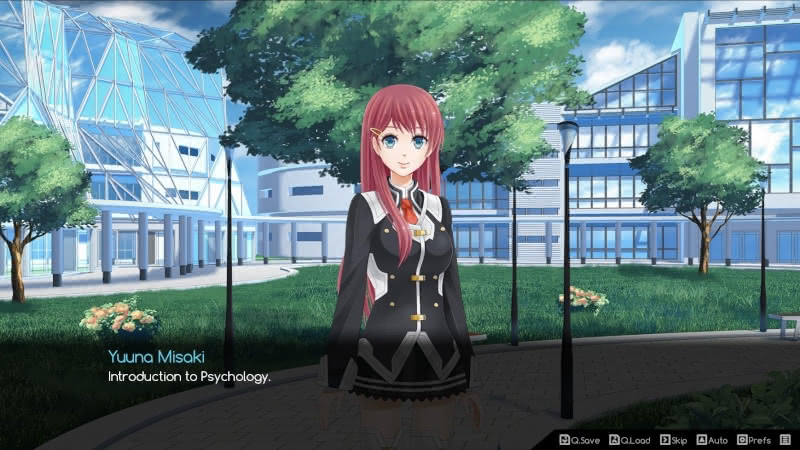
Yuuna’s character arc was decent and natural, but not particularly interesting unless one particularly likes her character and personality. Many of her best scenes come early in the game. A number of Yuuna’s mid-game scenes centering on her life at ACE Academy fell a bit flat for me. The central drama of her character arc should have, in theory, played a central role in the story of the protagonist’s career as a GEAR pilot, but it ultimately felt under-developed. However, in contrast to Mayu, Yuuna’s relationship with the protagonist feels credible, and the later scenes in her character arc are sweet and charming.
Valerie Belle is an engineering student. She is the only non-Japanese member of the main cast (with the exception of the protagonist’s half-Japanese sister), but she is French instead of American. Valerie fits the flirtatious archetype, being forward with the protagonist from their first meeting, albeit with some ulterior motives related to her academic interests.
Valerie is a strong character, and she has a credible case for having the best character arc depending on one’s mileage with Kaori’s tsundere tendencies. Her flirtatiousness yields humorous dialogue regardless of whether the protagonist plays along or acts as a stone wall. However, in writing Valerie’s jokes, the game bears in mind that she is supposed to be intelligent and it does a deft job of allowing Valerie to be serious when she is focused on her work.
Valerie’s character arc is well done. Her personal issue is modest, but very realistic and relatable. Her ending up in a relationship with the protagonist feels credible after the protagonist invests in spending time with her. Unlike Mayu and Yuuna, Valerie leaves an impression even when the protagonist does not invest in her events, and I will note that she has the best scenes for a character whose route is not chosen in the later stages of the story.
Overall Assessment: Kaori and Valerie are the strongest ACE Academy characters, with Kaori having the best personal character arc and Valerie having the second strongest personal arc but the best character development outside of her arc. Shou is a solid bro-character, so long as he is left in that role. Yuuna plays a leading role early in the story, but her character development is not as strong as that of Kaori and Valerie. Mayu lacks the strong personality of the rest of the cast, and she sees her best development in scenarios wherein the player does not pursue her route.
The scenes involving the protagonist’s family – most often Nikki and his Uncle Kaito – are generally good and do a good job of portraying a caring family (see my review of a scene in Persona 4 Golden for a similar, albeit even more heartfelt, example).
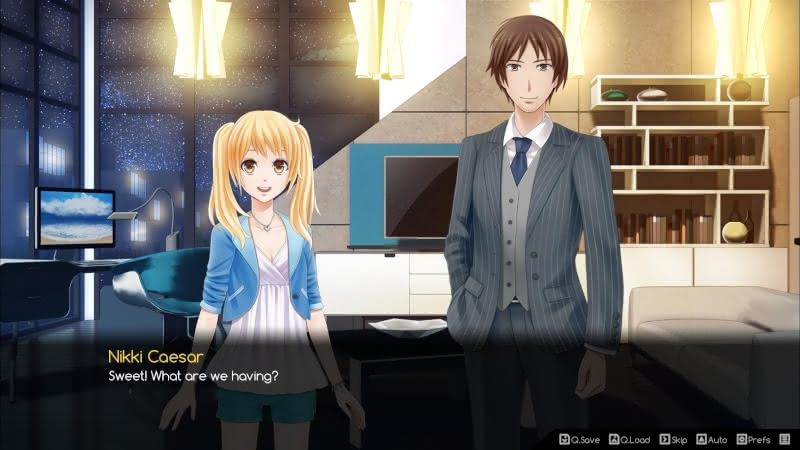
Given ACE Academy’s use of tropes, one may expect Nikki on first glance to be an annoying little sister character, but that she is responsible and able to mix teasing with sincerity makes her a solid character on the whole.
Aesthetics of ACE Academy
In this section, I will examine the appearance of ACE Academy. This analysis consists of three sections: Visuals, Voice Acting, and Music.
Visual Presentation
The main focus of ACE Academy’s visuals are its character designs. Each of the main characters in ACE Academy receives full character portraits along with a number of expressions and outfits. Kaori owns the greatest range of designs, but all of the main characters have good variety. A number of supporting characters who play meaningful roles in parts of ACE Academy also have full character portraits. The protagonist’s sister, Nikki, has a collection of expressions and outfits that rivals the main cast. One notable side-character design is that of Mei Satomi, who plays an important role in a mid-game common route event involving Kaori. While Mei does not have many scenes, the ACE Academy team gave her the most conventionally attractive character design.
The character portraits, on the whole, are impressive. Save for those who have issues with candy hair colors, all of the main characters are well drawn and have designs, expressions, and outfits that match and convey their personalities. Having noted Kaori’s variety, I will praise the team for Valerie’s confident and assertive design, which perfectly matches her character.

PixelFade Studios added a few additional nice touches to the characters. The characters blink, and in scenes where there is more than one character pleasant, astute observers will note that they blink at different times. There are examples of eye-shifting as well – this is used to good effect with Mayu in particular. While each character comes with a wide array of facial expressions, ACE Academy often adds thought bubbles to better illustrate their mood at a given moment.
Moreover, I am impressed with how well the Canadian team at PixelFade Studios was able to represent a distinctly Japanese aesthetic in the character drawings. ACE Academy is handles the style better than any English-language visual novel that I have played that comes to mind (I will note I have played a few Chinese visual novels that handle the aesthetic very well – see my review of LoveChoice).
Visual novels have different ways of depicting characters and text boxes on screen. In ACE Academy’s case, nearly the entire figure of the speaking character is displayed on screen, and as many as six characters are on screen at one time in a few scenes. The game uses this to good effect to highlight character outfits and, at times, to indicate the protagonist’s proximity to the person he is talking to. For example, in one early potential scene with Yuuna, the visual shows almost all of Yuuna, but places her further in the background than usual in order to indicate that the protagonist called to her as she is walking away.
However, the shadow of budgetary and time-management issues quite literally lurk in the designs of insignificant side characters. Those side characters who do not play a meaningful role in the story, such as professors, Nikki’s friends, and at least one potential love interest of one of the main cast members, are depicted as shadow people – much like many of the characters in the very pecular MYTH visual novel, which I covered in brief for a look at a humorous, unrelated issue.

However, unlike in MYTH, the shadow people of ACE Academy are not actual shadow people. Here, the ACE Academy developers noted themselves in a fourth-wall breaking scene that comes late in one of the character arcs that the inclusion of shadow characters was prompted by issues involving time and resources. While the shadow side characters are not game-breaking, they are a bit distracting and thus disappointing. Moreover, whenever a secondary character is introduced with a portrait, the player can readily infer that this non-shadow character will play some meaningful role in a part of the story.
The backgrounds in ACE Academy are serviceable, but largely forgettable. It is obvious that the team (rightfully) prioritized character designs over backgrounds. There are a few instances wherein backgrounds are re-used when they should not be. For example, certain backgrounds related to the school appear late in the game to represent locations that have nothing to do with the school.
ACE Academy has a total of 78 CGI gallery scenes, mostly involving GEAR fights and the four main female characters (a few feature Nikki). These scenes are still scenes that are fully drawn, and whenever the player encounters one, it is registered to the Gallery in the game’s Extras menu. A number of the 78 gallery scenes are stages within a single scene (for example, there are cases where there are four gallery scenes showing stages of a single event). In order to unlock all of the gallery scenes, the player must ultimately complete the routes of the four main female characters (Mayu, Kaori, Yuuna, and Valerie) while making a few subtle variations of certain choices early in the game (Shou’s route does not introduce any gallery scenes, nor does the comedic route that follows from the player not triggering any of the five main routes). These scenes are all well-drawn and high quality. Valerie’s collection shows particular care.
Finally, I will discuss ACE Academy’s user interface in brief. The game uses a semi-transparent text box in the bottom portion of the screen for dialogue, and the names of the speaking characters are color-coded (e.g., Shou is green, Nikki is yellow, Kaori is red). The transparent text box allows the player to see the full character portrait and background, and the text is always easy to read. Moreover, the menus are all intuitive to navigate and well-designed.
Voice Acting
ACE Academy is fully voice acted – which is no small feat. The only character who is not voiced is the protagonist. Even minor shadow characters have full voice acting, although they often share voice actors with one another.
A cursory look at ACE Academy reviews on Steam and elsewhere will reveal that there are some mixed opinions about the voice acting, ranging from praise to a minority insisting that it ruined the entire experience. On the whole, I am of the view that the voice acting was a net positive for ACE Academy and, while not perfect, solid on the whole. For those who hate it, it can be toggled off in the main menu (perhaps an advanced feature allowing people to adjust it by character would have been a nice addition, albeit not one that I would have used). In the interest of brevity, I will provide some brief notes on the voice acting for the characters with the most speaking parts only.
The stand-out voice acting performance in ACE Academy was delivered by Ms. Angela Lorenzana as Valerie Belle. The slightly raspy tone was good for delivering Valerie’s playful and flirtatious lines, but Ms. Lorenzana was able to switch gears (pun intended) when it came time for Valerie to offer a lecture about GEAR maintenance or to touch on a serious topic. Other stand-out performances include Mr. Kim Morton as Shou Shinjirou (good range and very consistent) and Ms. Tina Kim as Nikki (no small feat to voice the energetic little sister character without making her annoying). The protagonist’s Uncle, Kaito Hikari, was well-voiced by Mr. Bradley Petyak. I will also single out Ms. Amanda Lee as Mei Satomi for giving a notably good side-character performance.

My views on the remaining three main characters were a bit mixed. Kaori, voiced by Ms. Sydney Paniewaz, is the most complicated case. I chided ACE Academy a bit for overplaying Kaori’s “tsun” side early in the story. However, some of my issues there involved her early-game voice acting, where Kaori yells enough of her lines that one may struggle to choose to spend time with her, even while picking up on her character archetype. However, Kaori’s voice mellows after her first few scenes, and it is more level in scenes when the player chooses to spend time with her outside of the main story. Once Kaori stops yelling all the time, which begins in the second half of the first act, Ms. Paniewaz delivers a very good performance , perhaps second only to Ms. Lorenzana as Valerie. Kaori in the later stages of the game shows good voice range as her character develops.
Ms. Alexandra Boodram delivers a solid performance as Mayu, and an excellent one in a few scenes where Mayu asserts herself in discussions with the team. However, Mayu’s general lack of presence and a well-defined personality ultimately leads to her character, and voice, not being particularly memorable. Yuuna Misaki, voiced by Samantha Chan, was fine when talking normally but struggled to deviate from her default tone when called upon to express emotions such as happiness and frustration. I had few issues with Yuuna in her early scenes, but more problems as her character developed in her personal arc.
Music
ACE Academy has a total of 46 music tracks, each of which is added to the Extras menu after the player encounters it. The tracks all sound like synthesizer tracks. While none are particularly memorable or notable, they match the various moods of different sorts of scenes well, and on the whole the musical accompaniment for ACE Academy is solid and has enough variety to never become repetitive. Relative stand-out songs from the list are Fight Song 1 (used occasionally in the lead-up to mech battles), Hanging Out (one of the background tracks for daily life), Let’s Get it Done, Open Road, and the best of the collection, Timeless (end credits).
Skipping, History, and Other Technical Notes
ACE Academy is well configured for completionists who want to see all of the content that the game has to offer. To begin, ACE Academy has a feature for skipping previously-read text, something that is standard in almost all visual novels. This feature is combined with a huge number of save slots. I accumulated more than 70 save-points over my several play-throughs, and am in no danger of running out.
One peculiar feature of ACE Academy, which some may consider a bug and others a terrific quality of life point, is how its history functionality works. ACE Academy, like most visual novels, allows the player to review a certain amount of text history at any point. However, many visual novels with choices that I have played do not allow players to use the text history functionality to re-do choices. In ACE Academy, so long as a previously-made choice is within the ambient of the text history’s range, the player can re-do the choice by going back in time with the history functionality. This peculiar feature even applies to GEAR battles with timed choices. I would suggest not availing oneself to this feature on a first play-through since it renders nugatory the point of there being timed choices, but it did come in handy when I was working through the game to complete different routes and try different variations on choices. Those looking to abuse the history trick should bear in mind that history is limited and be wary of straying too far from a choice they may want to re-do. However, I note that the history functionality works after restoring save points, which is not the case in many visual novels that I have read.
(Note: The ability to abuse the skip functionality to re-do choices is not present in Kaori After Story.)
On the whole, ACE Academy is designed in such a way as to make it easy and painless for readers to complete all of the routes and collect all of the gallery scenes without needing to re-do many scenes without the benefit of skip functionality. In this way, the developers respect the time of players while encouraging players to discover everything that their game has to offer.
Extras
ACE Academy is a bit light on extra content for a multi-path visual novel with a significant number of endings. Its main extra features are the image gallery (which serves as a proxy for showing how much of the game the player has seen) and the jukebox (a nice feature, but unlikely to be well-used).
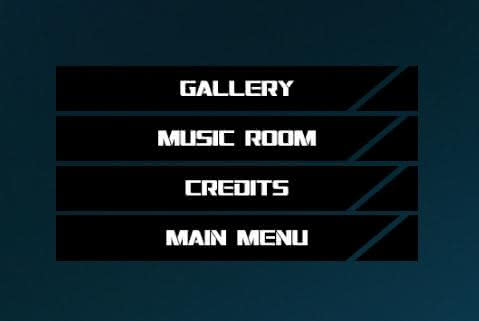
I would have liked to see a section highlighting the different endings after they are completed (a la Night of the Forget-Me-Nots) and some bonus material about the game’s development.
Overall Review
I enjoyed ACE Academy on the whole and, granting its flaws and unfinished points, I found it to be an impressive debut work for PixelFade Studios. As evidence of the fact that I enjoyed playing it, I did not start ACE Academy with the intention of reviewing it at The New Leaf Journal – in contrast to many of the visual novels of my ongoing al|together translation review project. I decided to review ACE Academy only after reading through the game and deciding that it was worth writing about. However, while I personally enjoyed ACE Academy, it is not a visual novel for every reader.
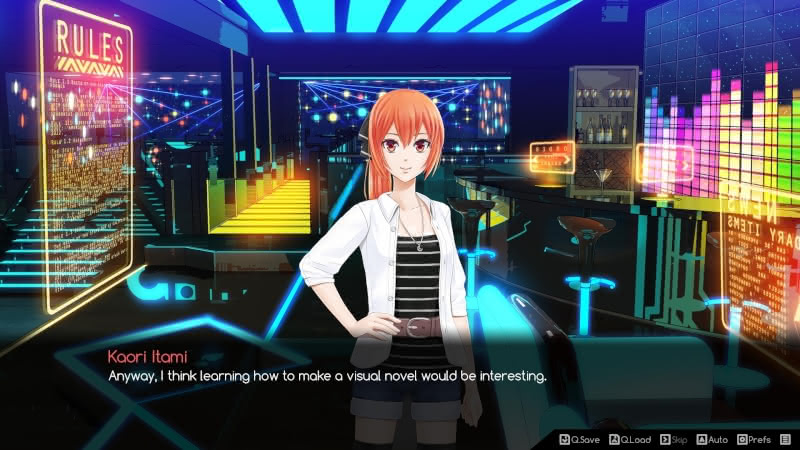
Below, I will conclude by weighing its strong and weak points in a final assessment.
Strengths
ACE Academy has impressive production values for an indie project with its length. While many of the choices are not ultimately meaningful, the choices consistently engage readers with the story. Many of the choices, including those that only affect a particular scene, allow the player to add his or her own preferred personality to the protagonist. In one play-through the protagonist can be reliable and polite. In another play-through the protagonist can be more of an “idiot” (as Kaori would put it) than Shou. Testing the effect of different choices adds a good amount of replay value to ACE Academy.
The writing quality in ACE Academy is high and consistent with what I would expect from a fully commercial English-language visual novel. While the story has some serious moments, it never takes itself too seriously. ACE Academy relishes in its tropes, but it makes a genuine effort to include interesting characters within those tropes. It succeeds in the cases of Kaori and Valerie, and does well enough (with all of the caveats I noted) regarding the other characters. The dialogue does not hide from tropes or being a bit campy, but ACE Academy is a good love letter to the genre and has enough quality to be a fun product separate and apart from its efforts to be an English visual novel inspired by Japanese works.
I think that the developers of ACE Academy made a good decision in making the main character an American transfer student to Japan. Firstly, because the player takes the role of the main character and ACE Academy is an English-language game, the main character being from an English-speaking country is good for immersion. Secondly, I can see some ways in which it was likely more comfortable to write the viewpoint character in this way.
While I do have a few qualms about how meaningful choices work in ACE Academy (see “weaknesses” section below), the team displayed a very impressive amount of attention to detail in ensuring that small events are reflected in dialogue of later events – even in cases where the difference does not meaningfully affect the course of the story. I found myself discovering and noticing unexpected surprises even in my later play-throughs. For example, I did not fully appreciate some of the subtle changes that follow from the player’s choice of an attribute at the start of the game until my later play-throughs. The developers were careful to maintain logical consistency in dialogue based on many minor events and decisions.
While there was a good amount of potential left on the table regarding GEARs and ACE Academy’s mystery plot, both fit in the overall story and did not detract from ACE Academy’s stronger focus on its characters and daily life. The quick choice events were well-conceived, and there is a decent amount of variety in outcomes of the GEAR battles for readers who are interested in testing different choices.
Finally, while reviews of the voice acting were mixed, the voice acting was good enough for all normal purposes and added to the overall production values of the project.
Weaknesses
Parts of ACE Academy are clearly unfinished. The story (on all routes) end with what feels like should be the beginning of a new story arc, and the events leading up to that ending were not as well-developed as they should have been had the sci-fi mystery plot in ACE Academy been better conceived. While the individual character arcs develop and conclude nicely, that ACE Academy ends in the middle of a never completed big revelation does not leave one feeling fully satisfied upon finishing the story. The existence of Kaori After Story serves as a better conclusion (for people who like ACE Academy and like Kaori in particular), but I thought it was notable that the team did not see fit to make even a passing reference to the events in the final scene of the first game – while otherwise continuing Kaori’s story from ACE Academy.
Throughout the post, I noted other parts of ACE Academy that felt, and feel, a bit unfinished. On one hand, ACE Academy is more than enough fun to invest 10-20 hours in to complete (or at least the routes a player is interested in), but the half-baked features and under-developed story-lines leave one feeling that it could have been more with greater resources and development time.
As I noted previously, some routes were stronger than others. Kaori and Valerie had strong routes and Yuuna’s route was solid, albeit unspectacular. The team clearly had more difficulty defining Mayu’s character, and as a result, she sees her best development when she is not the primary focus of the player’s attention. I appreciated the effort to give Shou a route, but it definitively proved that he is best as a supporting character.
While I will refrain from fully explaining how ACE Academy’s choices affect game-play, I will note that it ultimately uses what I would describe as a brute force choice implementation that heavily emphasizes who the player spends time with over how the player spends that time. This point is not absolute, and I noted in some cases, especially Kaori’s route, ACE Academy does demand a bit of finesse in making choices, but its overall structure in terms of locking in routes is more simple than one would expect on first glance.
The later stages of the game had some pacing issues. There are a number of events that are primarily comedic in nature that run close together in the later stages of the second part of ACE Academy and the early stages of the third. On my first play-through before I knew the ending, I found myself forgetting about the mystery surrounding Eagle’s core and the fact that the game involved intramural GEAR fights. Having noted ACE Academy is at its best as a character piece, the failure to spread out its fun scenes a bit more and balance the game’s different parts highlights that ACE Academy is not always entirely sure of itself and what it wants to be.
Final Thoughts
ACE Academy is a fun visual novel. If it sounds interesting to you from my description and review, I would recommend picking it up on Steam when it is on sale (or on mobile devices if you prefer that format). If it does not sound interesting to you from my review, I doubt that playing it would change your mind. ACE Academy requires some degree of interest in Japanese visual novel and anime tropes, and one will enjoy it more if he or she is specifically interested in seeing how an English-language development team applied them to their project. It should also be of interest to those who are interested in video game and visual novel design, especially choice structures (that ACE Academy is not too difficult to decipher is not a bad thing in this case) and the team’s careful attention to detail in writing dialogue.
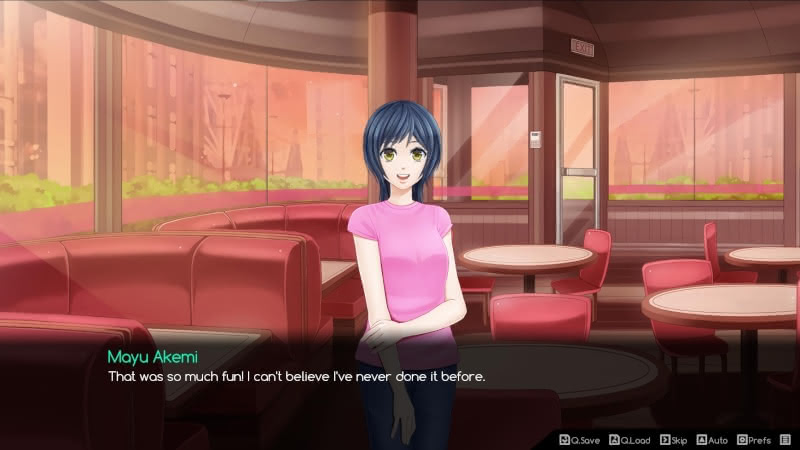
Thus, having enjoyed ACE Academy myself, I recommend it with the above caveats. If you played through the Kaori Itami route of ACE Academy, see my review of Kaori After Story.